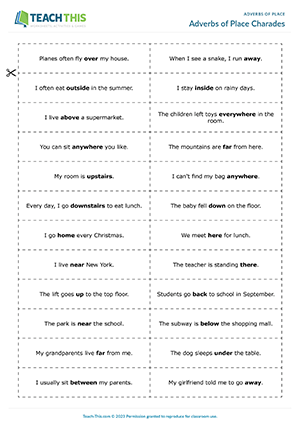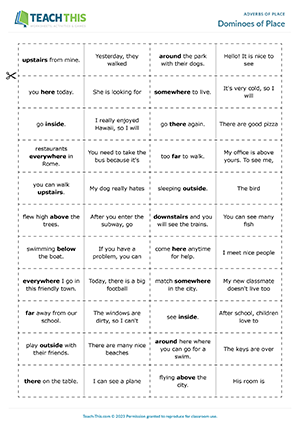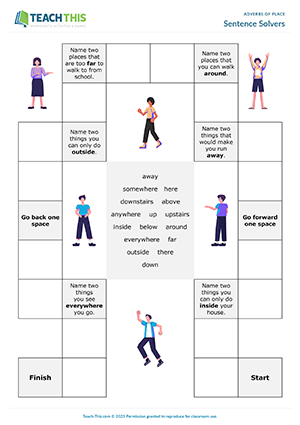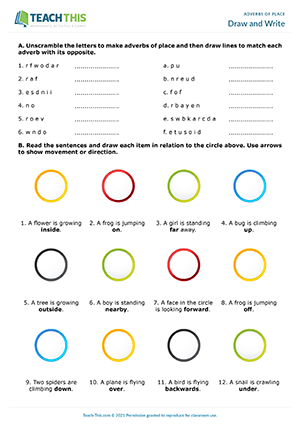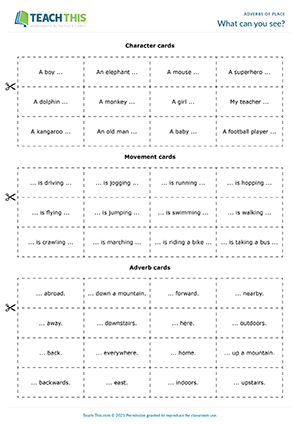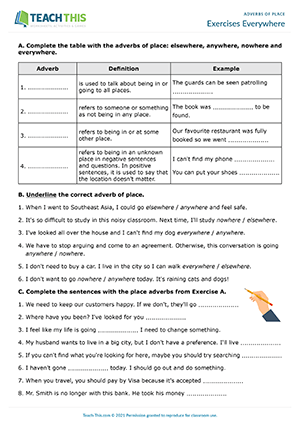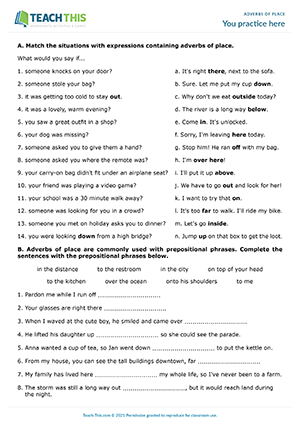In this free adverbs of place game, students mime adverbs of place in sentences for other students to guess. In groups, students take turns picking up a card and reading the sentence using the word 'blank' for the adverb of place in bold. The student then mimes the adverb of place in the sentence. The other students watch the mime and try to guess the adverb of place. The first student to guess the correct adverb and say the complete sentence wins and keeps the card. The student with the most cards at the end of the game wins. As a variation, you can play the game as a class with the students in two teams.
In this enjoyable adverbs of place game, students practice adverbs of place by matching dominoes together to make grammatically correct sentences. The first player puts a domino down either before or after the domino on the table, making sure that the two parts of the sentence match to make a suitable sentence that contains an adverb of place. The other players then take turns matching their dominoes in the same way by putting them down at either end of the domino chain. If a player cannot put down one of their dominoes, they take a domino from the top of the pile and put it down if they can. If there are no dominoes left in the pile, play passes to the next student. The first player to get rid of all their dominoes wins the game.
In this entertaining adverbs of place board game, students race to complete sentences with adverbs of place. In groups, students take turns picking up a card and reading the sentence to the other students using the word 'blank' for the adverb of place in brackets, e.g. 'I am very tired. I need to sit BLANK.' The other students listen to the sentence and race to choose an adverb of place from the game board and say it aloud to complete the sentence, e.g. down. The first student to say the correct adverb of place shown on the card rolls the dice and moves their counter along the board. If a student lands on a square beginning with 'Name two...', they name two things to match the description to remain on the square. If they are unsuccessful, they move back one space. The first student to reach the finish wins the game.
In this useful adverbs of place worksheet, students learn and practice place adverbs through drawing and writing exercises. First, students unscramble letters to make 12 adverbs of place and then draw lines to match each adverb with its opposite. Next, students read place adverb sentences and draw each item in relation to a circle. Students then indicate if sentences containing adverbs of place are right or wrong, correcting any mistakes. After that, students read a picture description and underline all the adverbs of place in the text. Finally, students draw a picture from a description that uses place adverbs.
In this fun adverbs of place game, students look at drawings and guess sentences that describe movement using place adverbs. A student from Team A comes to the front of the class and picks up a card (character, movement, and adverb) from each pile to make a sentence. The student then draws a picture illustrating the sentence on the board. This can be done by drawing one complete picture or by drawing each element separately. The first student in either team to identify the character, movement, and adverb of place being drawn, and make the correct sentence wins and scores a point for their team. A student from Team B then comes to the front of the class and picks up a card from each pile and so on. The team with the most points at the end of the game wins.
In this productive adverbs of place worksheet, students learn and practice a variety of place adverbs. Students begin by completing a table with the adverbs of place: elsewhere, anywhere, nowhere and everywhere. Next, students underline the correct adverbs of place in a set of sentences. After that, students complete sentences with the place adverbs from Exercise A. Students then complete a dialogue with adverbs of place from a box. Finally, students rewrite sentences based on the dialogue using adverbs of place.
This free adverbs of place worksheet helps students learn and practice adverbs of place, in contrast with related prepositions. To start, students match situations with expressions containing adverbs of place. Next, students complete sentences that contain adverbs of place with appropriate prepositional phrases. Students then read sentences and cross out the object of one preposition in each sentence to change it into an adverb. Lastly, students answer questions that use place adverbs and then discuss the questions with a partner.
Latest Free
Resources
- Count on Me!
Making Offers and Promises (A2)
Date Added: 11th of February
- It’s Carnival Time!
Cultural Celebrations (B1)
Date Added: 29th of January
- Identifying and Clarifying Problems
Dealing with Problems (B2)
Date Added: 1st of November
- The Bus Stop
Getting Around (B1)
Date Added: 1st of October
- Study Skills Showdown
Study Skills (B2)
Date Added: 10th of September
Latest Member
Resources
- Who has asked the right question?
Present Perfect Wh Questions (B1)
Date Added: 26th of February
- Perfectly Played!
Present Perfect Wh Questions (B1)
Date Added: 25th of February
- Present Perfect Wh Question Time
Present Perfect Wh Questions (B1)
Date Added: 24th of February
- Express, Justify and Debate!
Speaking Test Preparation (B1)
Date Added: 20th of February
- Logical Fallacy Bingo
Critical Thinking (B2)
Date Added: 20th of February



